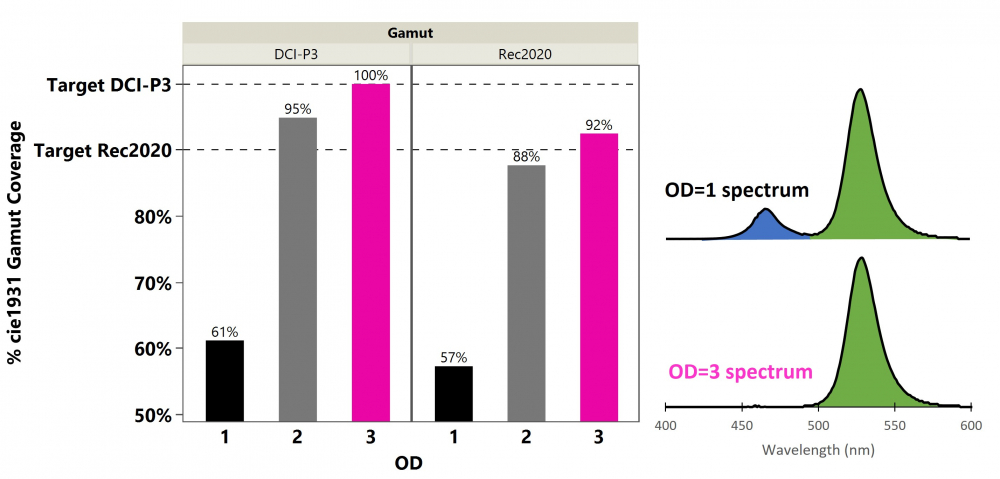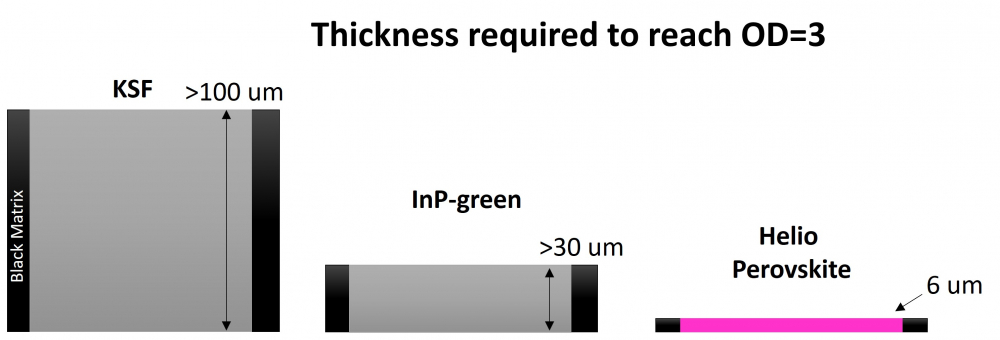Blocking the Blue: The benefits of highly absorbing perovskites
Link to this article in Chinese 挡住蓝光
The incredible optical properties of perovskites, including high quantum yield and pure colour emission, are well known. But before a photon can be emitted, one must be absorbed. This Helio Blog introduces the uniquely high optical absorption of perovskites and explains why this is so important for the new generation of display architectures built on in-pixel colour conversion.
In-pixel colour conversion requires high Optical Density and thin layers
The ability of an optical layer to absorb light of a certain wavelength range is described by its Opical Density or OD for short. For display architectures that use in-pixel colour conversion, we are most interested in the absorption of blue light which will typically be emanating from a blue LED (in the case of µLED) or a blue OLED layer (in the case of QD-OLED).
At OD=1, 90% of blue light is absorbed.
At OD=2, 99% of blue light is absorbed.
At OD=3, 99.9% of blue light is absorbed.
In the colour conversion architectures we are considering, the colour conversion layer will emit either red or green depending on the sub-pixel. But what happens to the blue light that doesn't get absorbed, and therefore what OD is required?
Figure 1 below shows that a high performance display (e.g. 100% DCI-P3) would require a colour conversion layer with OD=3, and this would have to be at thickness that would make the display manufacturable (10 micron or less). So, we need a material that can absorb blue light with OD=3 in a very thin film without sacrificing color purity and efficiency.

Figure 1: Effect of OD on colour gamut. Colour gamut increases dramatically towards full gamut coverage as the amount of blue light leakage decreases (OD increases). The data to generate this figure is based on a commercial blue LED with Helio perovskite materials (Ref. 1). Further optimisation of gamut may be possible by shifting wavelengths but at the cost of decreased brightness.
Helio's perovskite-based solution
Helio’s perovskite materials have been optimized and specifically formulated to achieve a very high OD per micron of film thickness. Both red and green versions of Helio’s materials can achieve OD=3 in 6 microns or less, meaning that a colour filter is not required to further purify the outgoing light. This reduces cost and enhances the overall efficiency of the colour converting layer. In the case where a color filter is still desirable to manage ambient contrast ratio, an even thinner film of 2-3 um can be leveraged to further decrease manufacturing cost.
In addition, the thinner the colour conversion layer, the higher the display resolution that can be achieved within the practical limits of the aspect ratio between the vertical and horizontal dimensions of the pixel.
Comparing perovskites to leading alternative technologies for colour conversion highlights the striking impact that perovskite materials can have on the physical structure required to achieve a given OD. Figure 2 shows the required thickness of the colour conversion layer to achieve OD=3 using three color-converting technologies. For KSF phosphor this thickness is >100 microns due to the low absorption of this material (Ref. 2). InP-green material has better light absorption properties, but would still require >30 microns to reach OD=3 as its intrinsic absorption coefficient is far lower than perovskites (Ref. 3). In contrast, Helio has demonstrated perovskite materials that can achieve OD=3 at a thickness of only 6 micron.

Figure 2. Thickness required to reach OD=3 with different color-converting materials. Aspect ratio shown is accurate for a ~100 um wide sub-pixel which is similar to what is used in QD-OLED.
The thinner colour conversion layers enabled by perovskites also provide significant benefits for the optical design because the sidewalls have less of an effect. For example, optical modelling of a QD-OLED pixel has shown that optical losses due to sidewall absorption will reduce from 42% to 27% if the layer thickness is reduced from 15 micron to 5 micron (Ref. 4).
In conclusion, the combination of excellent optical emission properties together with best-in-class absorption makes perovskites an ideal choice for colour conversion. That is why Helio is developing a compatible set of red and green perovskite materials targeted specifically at the new generation of colour conversion enabled display architectures including µLED and QD-OLED.
To find out more about Helio can help with your display design challenge, please contact us here.
References
- Blue LED was a Nichia NHSB146AT. Colour gamut from spectral measurements of Helio prototype materials.
- Based on an absorption coefficient of 51 cm-1 estimated from:
- F. Garcia-Santamaria et al 2018 ECS J. Solid State Sci. Technol. 7 R3030
- Osborne et al Optical Materials 107 (2020) 110140
-
- Nanosys presentations, SID Display Week 2019 and QD Forum 2020
- Osinski & Palomaki, 4-5, 2019 SID Symposium Digest of Technical Papers, 50 (1)
- Palomaki & Twietmeyer, 26-3, 2022 SID Symposium Digest of Technical Papers, 53 (1)